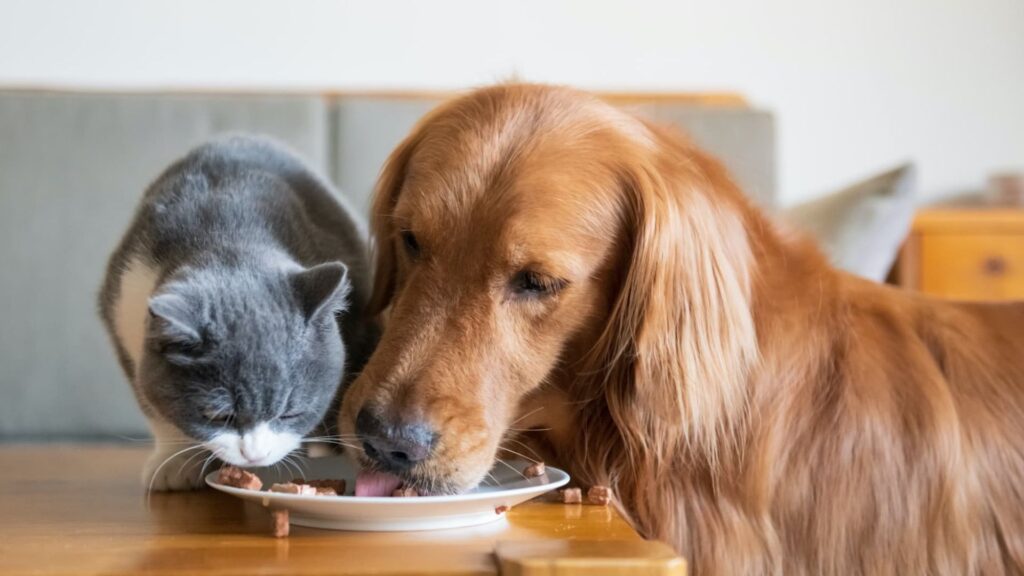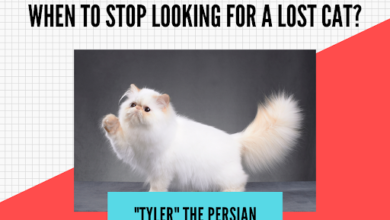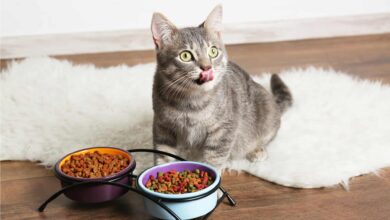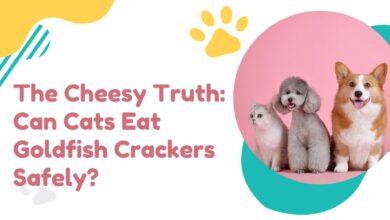
I’ll never forget the day I caught my cat Maisie gobbling down my dog Max’s kibble. Her face was halfway into Max’s bowl before I shooed her away.
But it got me wondering—can cats eat dog food, or is it dangerous for them?

Cats and dogs may both be furry, four-legged pets, but they have very different nutritional needs. Dog food contains lots of ingredients that can be harmful to cats if consumed regularly.
However, in moderation or emergencies, dog food likely won’t seriously harm your cat.
Comparison – Dogs vs. Cats
Cats require much more protein than dogs—at least 30% of their diet versus 18% for dogs. They also need the amino acid taurine, which isn’t essential for dogs.
Cats are obligate carnivores, meaning they must eat meat and can’t synthesize some nutrients. Dogs are more omnivorous in nature ASPCA guidance.
- Dog food is lower in protein and lacks supplemental taurine required for cats.
- It’s also higher in carbohydrates, which cats have difficulty digesting.
- Fiber levels tend to be higher as well, while cats need only 5% fiber. Excess can cause diarrhea.
- Fatty acids like arachidonic acid are essential for cats but optional for dogs.
- Vitamins like vitamin A and niacin have different optimal levels for cats versus dogs.
- Minerals like calcium and phosphorus need precise ratios in cat food to prevent urinary tract disease.
The bottom line is dog and cat nutritional needs differ quite a bit PetMD. While occasional nibbles of dog food won’t harm cats, long-term dog food feeding can lead to malnutrition and health issues over time.
Potential Risks
Some potential risks include:
- Nutritional deficiencies. Lack of taurine can cause heart and eye issues in cats. Too little protein leads to muscle wasting.
- Dehydration. Cat kidneys struggle filtering excess carbs and fiber in dog food.
- Obesity. Dog food has more fat and calories than cats require.
- Pancreatitis. High fat diets can inflame the pancreas.
- Heart disease. Taurine deficiency wears down the heart muscle.
- Urinary tract infections. Improper calcium: phosphorus ratios crystalize the urine.
Despite the risks, feeding dog food does have some benefits for cats:
- Higher protein. Dog food protein percentages are closer to cats’ needs than most cat food.
- Fewer carbs. The lower carbohydrate load may benefit diabetic cats.
So, when is it acceptable to feed a cat dog food?
- As a rare treat, a bite or two of dog food is fine.
- If your cat is already stealing the dog’s dish, some dog food is better than none.
- For fussy eaters refusing cat food, dog food can provide appetite stimulation.
- For weight loss, higher protein, lower carb dog food can aid fat burning.
Check with your vet before feeding dog food long-term, and transition slowly if needed to avoid gastrointestinal upset. With some care, you may find dog food benefits your cat’s nutrition
Read More: Can Cats Eat Cheese?
Help! My Cat is Addicted to the Dog’s Food – How to Make the Swap Safely
Now that we’ve covered the basic nutritional differences between cat and dog food, let’s dive into the health risks of feeding dog food to cats long-term.
While the occasional bite of dog food is fine, a steady diet of dog kibble can lead to malnutrition and disease in cats over time.
Some of the most common health issues stem from nutritional deficiencies. Without adequate taurine from meat sources, cats can develop dilated cardiomyopathy, where the heart muscle weakens ASPCA guidance.
Taurine deficiency also causes eye problems like retinal degeneration and blindness. Dog food lacks supplemental taurine since dogs can synthesize their own.
- Too little protein in dog food leads to loss of muscle mass and lean body weight in cats.
- Deficiencies in vitamins like vitamin A and niacin can also develop because dog food doesn’t meet cats’ higher requirements.
Excess carbs and fiber in dog food puts strain on cats’ organs:
- Dehydration happens as the kidneys struggle to filter out the carbohydrate load. Many cats don’t drink enough water on their own to compensate.
- Obesity can occur because dog foods contain more fat and calories to fuel large dogs, while cats are built for intermittent hunting and eating.
- Pancreatitis is another risk, since inflammation of the pancreas is linked to high fat diets. Dog food tends to be higher in fat than cat food.
- Heart disease can develop if taurine deficiency from dog food wears down the heart muscle over time.
- Urinary tract infections and crystals form because the calcium: phosphorus ratios in dog food aren’t optimized for cats.
- Diarrhea or constipation commonly occur because of the higher fiber content of dog food.
What do the Experts Say?
To get a better idea of how dog food impacts cats long-term, I interviewed Dr. Sarah Johnson, a veterinarian specializing in feline nutrition and health. She shared the story of two cat patients:
“For litter mates Max and Ruby, dog food made up about 50% of their diet since they were kittens because the owner thought it was fine as long as they also ate cat food.
By age 3, Ruby began suffering urinary tract infections and blockages from crystalline buildup. Max was diagnosed as obese at 7 lbs. and lethargic. A switch to all cat food resolved these issues over time.”
What Does it Suggest?
This case shows that even with some cat food in the diet, the dog food still caused significant health problems. While not all cats will react the same way, it illustrates the risks.
On the other hand, Dr. Johnson says a taste of dog food now and then won’t harm cats:
“An occasional bite of dog food, like if your cat sneaks it when you’re not looking, isn’t going to cause deficiencies or illness by itself. Just don’t make it a regular thing.“
In summary, regularly feeding cat dog food long-term can negatively impact their health over months or years. Some cats tolerate it better than others genetically.
With care and vigilance, your cat can avoid the pitfalls of a dog-based diet.
The Cross-Species Food Feud: Transitioning Your Cat to a Dog Diet
We’ve covered the risks of feeding dog food to cats long-term. But what if your finicky feline refuses to eat cat food? Or your cat is already addicted to stealing dog kibbles?
Here’s how to transition cats to dog food safely…
First, any switch between cat foods or to dog food should be gradual. An abrupt change can upset their digestive system.
Start by mixing a small amount of new food in – say 10% dog food mixed into their normal cat food. ASPCA guidance recommends starting with a ratio of 25% new food to 75% previous food, and adjusting as needed.
Gradually increase the ratio of new to old food over 2-3 weeks. If your cat has diarrhea, gas, or constipation, slow the transition.
Make sure to keep your cat well hydrated by providing wet food, broths, or tuna juice to supplement the dry kibble, which is dehydrating.
What Else Can You Do?
You can also add some warm water to moisten the kibble to make it smell more appealing and aromatic. Proper hydration will help their kidneys filter excess carbs.
Monitor your cat closely for signs of intolerance like vomiting, diarrhea, lethargy, or poor appetite. If any symptoms occur, stop transitioning and call your vet. It’s possible your cat may never adjust to dog food.
Cats with kidney disease, heart disease, urinary tract conditions, or other health issues should avoid dog food altogether unless the vet recommends it.
For healthy cats, some dog foods are safer picks than others when transitioning diets. The best choices should mimic cat food as closely as possible.
Ideally, look for:
- High protein around 30% or more
- Moderate fat under 15%
- Low carbohydrates under 5%
- Added taurine
- Limited ingredients/novel proteins like duck or venison to reduce food sensitivities
Some dog food brands market themselves as safe for cats. PetMD recommends these specialty formulas for finicky felines.
In summary, transition slowly, watch for intolerance signs, and pick lower carb, higher protein dog foods to reduce the risks. Some cats do adapt to dog food, but it’s important to monitor their health closely.
Work with your vet to find the right diet balance. With time and patience, both cats and dogs can peacefully share mealtime!



